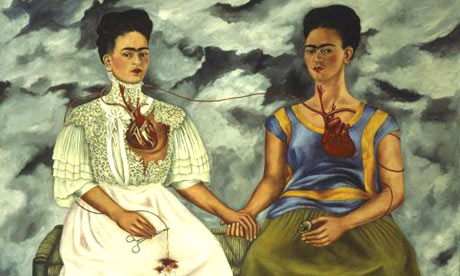
More than half a century after her death, the Mexican surrealist who had Leon Trotsky and Josephine Baker as lovers and Diego Rivera as her husband, soulmate and tormenter-in-chief, is at the centre of a new controversy.
Fittingly for an artist who insisted, "I paint my own reality", the latest row over Frida Kahlo revolves around truth and authenticity.
Princeton Architectural Press, which will soon publish a book of Kahlo's oil paintings, diary entries and personal letters, says it has stumbled across "an astonishing lost archive of one of the 20th century's most revered artists … full of ardent desires, seething fury, and outrageous humour."
But news of the discovery has prompted a group of Kahlo scholars to denounce the items – which belong to an antique-dealing Mexican couple who bought them from a lawyer who got them from a woodcarver who claimed to have got them from Kahlo – as fakes.
They also urged Mexico's National Council for Culture and the Arts and the National Institute of Fine Arts to protect the work of one of its favourite daughters and "to put a stop to this type of fraud and clarify the situation".
Others have been less temperate in their response. "It's a silly book," said Mary-Anne Martin, a New York-based Latin American art dealer who has sold many of Kahlos works. "But it has been put together very carefully and very cleverly. It is full of biographical material that would appeal to people into Kahlo and her relationship with Rivera, her feminism and her communism. Those bits have been created to that end."
Martin admitted that she had not personally seen the collection, adding: "This is not the kind of thing that any expert or any person who is reasonably knowledgable about Frida Kahlo would make the trip for."
"If I had to jump on a plane every time somebody made a fake painting, I would never get any work done."
The owner of the contested discovery, Carlos Noyola, runs an antique shop with his partner, Leticia Fernández, in San Miguel de Allende, central Mexico. He appears convinced of the authenticity of his 1,200-piece collection.
"We did acquire the collection with the belief and some groundwork done to prove that it is in fact authentic and thus paid accordingly," he told the Art Newspaper, adding that the collection was not – and never would be – for sale.
Barbara Levine, the curator who co-wrote the 256-page book on the artist, said Finding Frida Kahlo was meant to be a "personal encounter with the materials", not an academic textbook.
She said: "If I had made an art historical book about Kahlo or set out to prove the authenticity of the Noyola collection it would have been appropriate for me to consult with Frida Kahlo experts."
However, the book was "about the personal belongings of an icon not from the point of view of telling her story or contributing to her place in art history, but instead from the perspective of our essential human need to accumulate talismans, keep scraps to remember, track time and leave legacy".
A spokeswoman for Princeton Architectural Press, which will publish the book in November, said that as far as the company and the Noyolas knew, none of the Kahlo experts who had questioned the collection's authenticity had actually examined it first-hand.
Given that the author and publishers were keeping an open mind, she added, it was "curious" that guardians of Kahlo's legacy were not doing the same.
Anyway, she said: "These doubts are explored directly in the book, including a lengthy interview with the owners of the store and collection, the Noyola family, who believe, based on analyses by a chemical engineer and a graphologist, as well as interviews with members of the Kahlo family and some of her followers and students, that the materials in the cases are legitimate."

